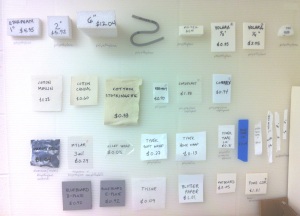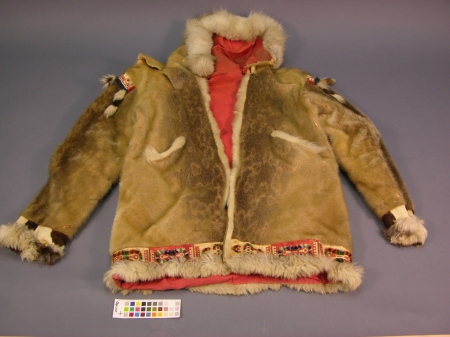
Sample board of supplies and comparative cost per square foot. In the collections processing room, Alaska State Museum, summer 2013
As the Alaska State Museum gears up to move out of its old facility, we’ve been busy ordering and consuming supplies to ready collections for the move. When you have a choice about what material to use in a given application, which one is more economical? For the new staff, volunteers, and contractors…what materials are we talking about? I put together a sample board of products and how much they cost per square foot, mounting the items with hot glue on a sheet of Coroplast and hanging it on the wall above one of the workstations where people are making storage supports. I’ve also got a list of what we’ve been using in summer 2013, where it comes from and how much it costs per square foot. Remember, we’re in Juneau, Alaska. Yes, we are the capital city but we are not on the road system. Everything comes here by boat or by airplane. Shipping costs are a big deal.
| ITEM |
SOURCE |
$$ SQ FT w/shipping |
| Backer Rod 3/8” |
GoodHardware |
$0.21 |
| Backer Rod ½” |
GoodHardware |
$0.24 |
| Backer Rod 5/8” |
GoodHardware |
$0.27 |
| Blotter paper |
Talas |
$1.01 |
| Blueboard Bflute |
Talas |
$0.92 |
| Blue tape 1.14” |
Home Depot |
$0.04 |
| Corex |
Local, AJE |
$0.94 |
| Coroplast |
Metal Edge |
$1.88 |
| Polyethylene Foam 1” |
IR Specialty |
$4.35 |
| Polyethylene Foam 2” |
IR Specialty |
$5.92 |
| Polyethylene Foam 6” |
IR Specialty |
$12.04 |
| Foam Cor |
Metal Edge |
$1.21 |
| Marvel Seal |
Talas |
$1.04 |
| Matboard |
Daniel Smith |
$2.05 |
| Minicell 1” |
IR Specialty |
$3.40 |
| Muslin thin |
JoAnne |
$0.22 |
| Muslin thick |
JoAnne |
$0.60 |
| Mylar 3mil |
Talas |
$0.29 |
| Pallet Wrap 3” |
AIH |
½ cent |
| Pallet Wrap 15” |
AIH |
$0.02 |
| Reemay |
Talas |
$0.90 |
| Stockingette 6” |
Fisher Sci |
$0.33 |
| Teflon tape 1” |
AIH |
$0.05 |
| Teflon tape ¾” |
AIH |
$0.04 |
| Teflon tape ½” |
Home Depot |
$0.06 |
| Tissue |
Talas |
$0.09 |
| Trapez. Rod 1” |
Univ. Products |
$1.50 |
| Trapez. Rod 2” |
Univ. Products |
$2.41 |
| Twill Tape 1” |
Talas |
$0.21 |
| Tyvek Homewrap |
Home Depot |
$0.13 |
| Tyvek tape 2.25” |
Talas |
$0.31 |
| Tyvek Softwrap |
MasterPak |
$0.27 |
| Volara 1/8” |
Fisher Sci |
$0.85 |
| Volara ¼” |
Fisher Sci |
$3.05 |
How to calculate square feet: multiply L x W in inches, then divide by 144 (12 x 12 is a square foot). Then visualize and imagine if that makes logical sense. Our collections room floor tiles are one square foot. I have a bigger spreadsheet that breaks out columns for how much product and what the shipping costs are, but just posted the conclusions in the table above.
In June 2013, I checked AIH, Home Depot, Valley Lumber and JoAnne in search of products I might get locally especially Teflon tape, tyvek, twill tape, blue tape, pallet wrap, backer rod, and muslin. Valley Lumber has palletizer, too, supplied by U-line with a cardboard tube. The 20” is cheaper than the AIH 15”, but their 3” costs more. Home Depot palletizer is green colored, which makes us museum folks suspicious of unnecessary additives or the risk of staining. Please note, we don’t use blue tape or pallet wrap for storing our collection, just for moving it. More postings on that to come…
Home Depot Tyvek is Homewrap, not needle punch softwrap, and has words printed on it. Valley Lumber carries Tyvek Homewrap, too, but it costs more. Beware: “Tyvek tape” we want is made of white Tyvek carrier, not the kind of clear carrier tape that is used to tape Tyvek to Tyvek. If you’re curious about what all these products are made from and what museums use them for, check out the excellent website CAMEO (Conservation & Art Materials Encyclopedia Online), a searchable inormation resource developed by the Museum of Fine Arts, Boston.
Tri Rod is no longer on the market, replaced by trapezoidal rod from University Products. However, it looks from images on the web that it might not have the smoothness on all exterior surfaces that we like. We ordered some and will evaluate.
Sources:
Local sources include Alaska Industrial Hardware (AIH), Home Depot, Valley Lumber, Good Hardware, and JoAnne Fabrics.
The State of Alaska has a contract with Fisher Scientific, which includes a discount and free shipping. This is a huge savings for us.
Our local source for affordable Corex is a sign printing company for where our exhibit designer AJE used to work. Technically, we should call this stuff Corflute sheet, as Corex is the manufacturer who makes this twin walled polypropylene sheet. but the local sign company we buy from calls it Corex, so we’ve fallen into the habit too. While I’m at it, I might as well mention my flagrant abuse of the term “Ethafoam” here too…we tend to use it for any good quality polyethylene foam we use, much in the same way folks might say “Kleenex” for a different brand of facial tissue.
Talas, Metal Edge, Daniel Smith, MasterPak and University Products are vendors with an online presence that are often used by museums. We have found them the most cooperative of the many vendors available when it comes to Alaskan shipping issues.
IR Specialty is a specialty foam company in Fife, Washington that also has a website.









 Posted by ellencarrlee
Posted by ellencarrlee 